Multi-Objective Optimization of Permanent Magnet Synchronous Motor for Electric Vehicle Considering Demagnetization
Abstract
1. Introduction
2. Demagnetization Analysis
2.1. Initial Model
2.2. Demagnetization Analysis Conditions
2.3. Demagnetization Analysis Results
3. Design Optimization
3.1. Optimization Process
3.2. Multi-Objective Function, Constraints, and Design Variables
3.3. Design of Experiment
3.4. Metamodeling
3.5. Optimization Results
4. Conclusions
Author Contributions
Funding
Institutional Review Board Statement
Informed Consent Statement
Data Availability Statement
Acknowledgments
Conflicts of Interest
References
- You, Y.-M.; Chung, D.-W. Optimal Design of a Permanent Magnet Synchronous Motor to Improve Torque and Demagnetization Characteristics. J. Magn. 2017, 22, 423–429. [Google Scholar] [CrossRef]
- Kim, B.-C.; Lee, J.-H.; Kang, D.-W. A Study on the Effect of Eddy Current Loss and Demagnetization Characteristics of Magnet Division. IEEE Trans. Appl. Supercond. 2020, 30, 1–5. [Google Scholar] [CrossRef]
- Zhang, Y.; McLoone, S.; Cao, W.; Qiu, F.; Gerada, C. Power Loss and Thermal Analysis of a MW High-Speed Permanent Magnet Synchronous Machine. IEEE Trans. Energy Convers. 2017, 32, 1468–1478. [Google Scholar] [CrossRef]
- Jeong, C.-L.; Kim, Y.-K.; Hur, J. Optimized Design of PMSM With Hybrid-Type Permanent Magnet for Improving Performance and Reliability. IEEE Trans. Ind. Appl. 2019, 55, 4692–4701. [Google Scholar] [CrossRef]
- Song, T.; Zhang, Z.; Liu, H.; Hu, W. Multi-objective optimisation design and performance comparison of permanent magnet synchronous motor for EVs based on FEA. IET Electr. Power Appl. 2019, 13, 1157–1166. [Google Scholar] [CrossRef]
- Guo, H.; Tian, W.; Xaiofeng, D. Multi-objective Optimal Design of Permanent Magnet Synchronous Motor for High Efficiency and High Dynamic Performance. IEEE Access 2018, 6, 23568–23581. [Google Scholar]
- Zhao, W.; Wang, X.; Gerada, C.; Zhang, H.; Liu, C.; Wang, Y. Multi-Physics and Multi-Objective Optimization of a High Speed PMSM for High Performance Applications. IEEE Trans. Magn. 2018, 54, 1–5. [Google Scholar] [CrossRef]
- You, Y.-M. Multi-objective optimization of a permanent magnet synchronous motor based on an automated design and analysis procedure. Microsyst. Technol. 2020, 26, 3477–3488. [Google Scholar] [CrossRef]
- You, Y.-M. Optimal Design of PMSM Based on Automated Finite Element Analysis and Metamodeling. Energies 2019, 12, 4673. [Google Scholar] [CrossRef]
- Kang, G.-J.; Park, C.-H.; Choi, D.-H. Metamodel-based design optimization of injection molding process variables and gates of an automotive glove box for enhancing its quality. J. Mech. Sci. Technol. 2016, 30, 1723–1732. [Google Scholar] [CrossRef]
- Zhang, B.; Song, B.; Mao, Z.; Tian, W.; Li, B.; Li, B. A Novel Parametric Modeling Method and Optimal Design for Savonius Wind Turbines. Energies 2017, 10, 301. [Google Scholar] [CrossRef]
- You, Y.-M.; Lipo, T.A.; Kwon, B.-I. Optimal Design of a Grid-Connected-to-Rotor Type Doubly Fed Induction Generator for Wind Turbine Systems. IEEE Trans. Magn. 2012, 48, 3124–3127. [Google Scholar] [CrossRef]
- You, Y.M.; Jung, D.W. A Study on Performance Improvement of Polygon Mirror Scanner Motor. J. Electr. Eng. Technol. 2019, 14, 745–755. [Google Scholar] [CrossRef]
- Kwon, J.W.; Lee, J.H.; Zhao, W.L.; Kwon, B.I. Flux-Switching Permanent Magnet Machine with Phase-Group Concentrat-ed-Coil Windings and Cogging Torque Reduction Technique. Energies 2018, 11, 2758. [Google Scholar] [CrossRef]
- Chai, W.P.; Lipo, T.A.; Kwon, B.I. Design and Optimization of a Novel Wound Field Synchronous Machine for Torque Per-formance Enhancement. Energies 2018, 11, 2111. [Google Scholar] [CrossRef]
- Li, Y.; Song, B.; Mao, Z.; Tian, W. Analysis and Optimization of the Electromagnetic Performance of a Novel Stator Modular Ring Drive Thruster Motor. Energies 2018, 11, 1598. [Google Scholar] [CrossRef]
- Butler, N.A. Optimal and orthogonal Latin hypercube designs for computer experiments. Biometrika 2001, 88, 847–857. [Google Scholar] [CrossRef]
- Deb, K. A Fast and Elitist Multiobjective Genetic Algorithm: NSGA-II. IEEE Trans. Evol. Comput. 2002, 6, 182–197. [Google Scholar] [CrossRef]
- Horiuchi, T. Demagnetization Function; ANSYS Korea: Seoul, Korea, 2016. [Google Scholar]
- Chau, K.T. Electric Vehicle Machines and Drives: Design, Analysis and Application, 1st ed.; Wiley-IEEE: Hoboken, NJ, USA, 2015; p. 243. [Google Scholar]
- PIDOTECH Inc. PIAnO User’s Manuals and Tutorials; PIDOTECH Inc.: Seoul, Korea, 2019. [Google Scholar]
- You, Y.-M. Multi-Objective Optimal Design of Permanent Magnet Synchronous Motor for Electric Vehicle Based on Deep Learning. Appl. Sci. 2020, 10, 482. [Google Scholar] [CrossRef]
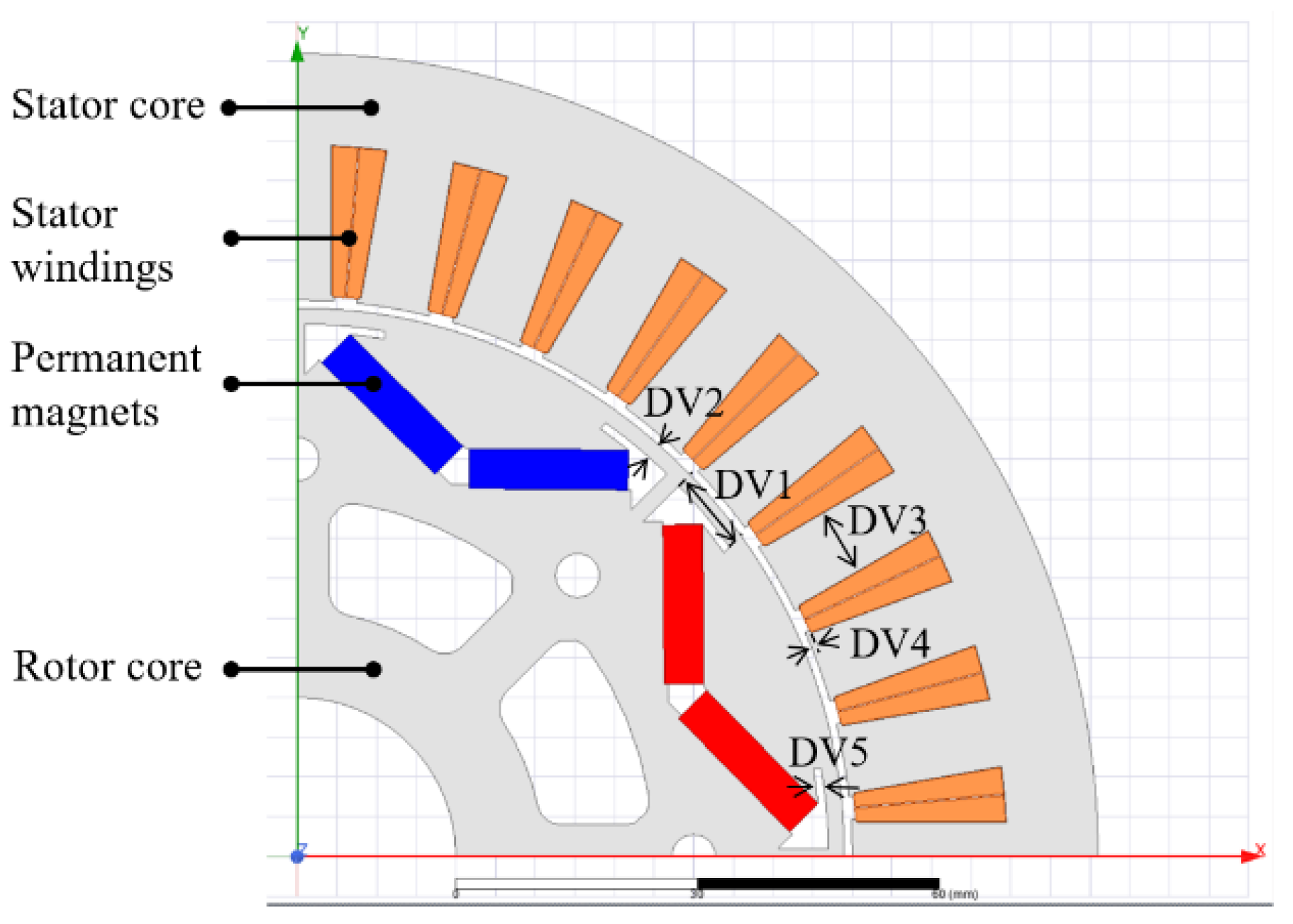
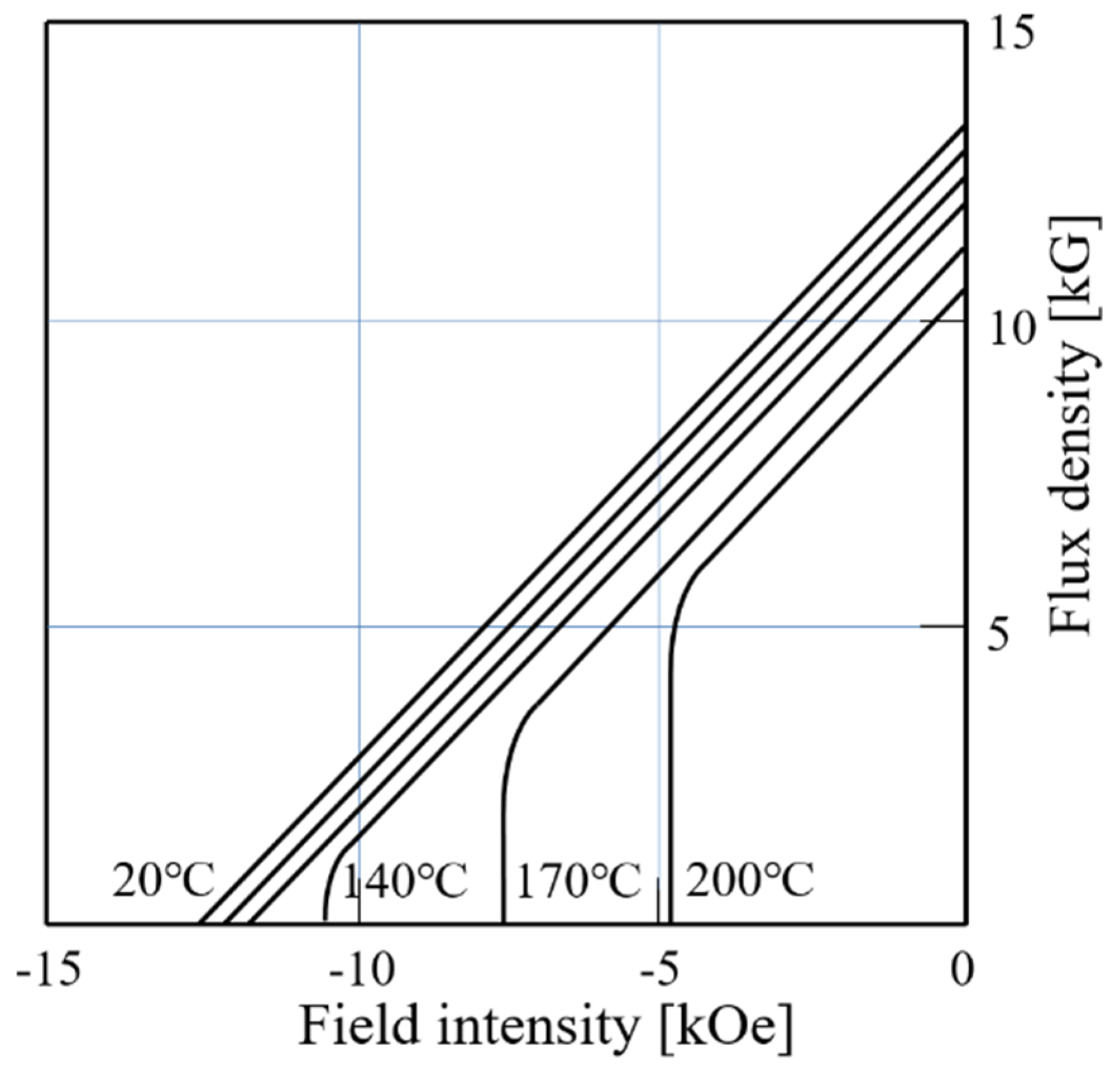
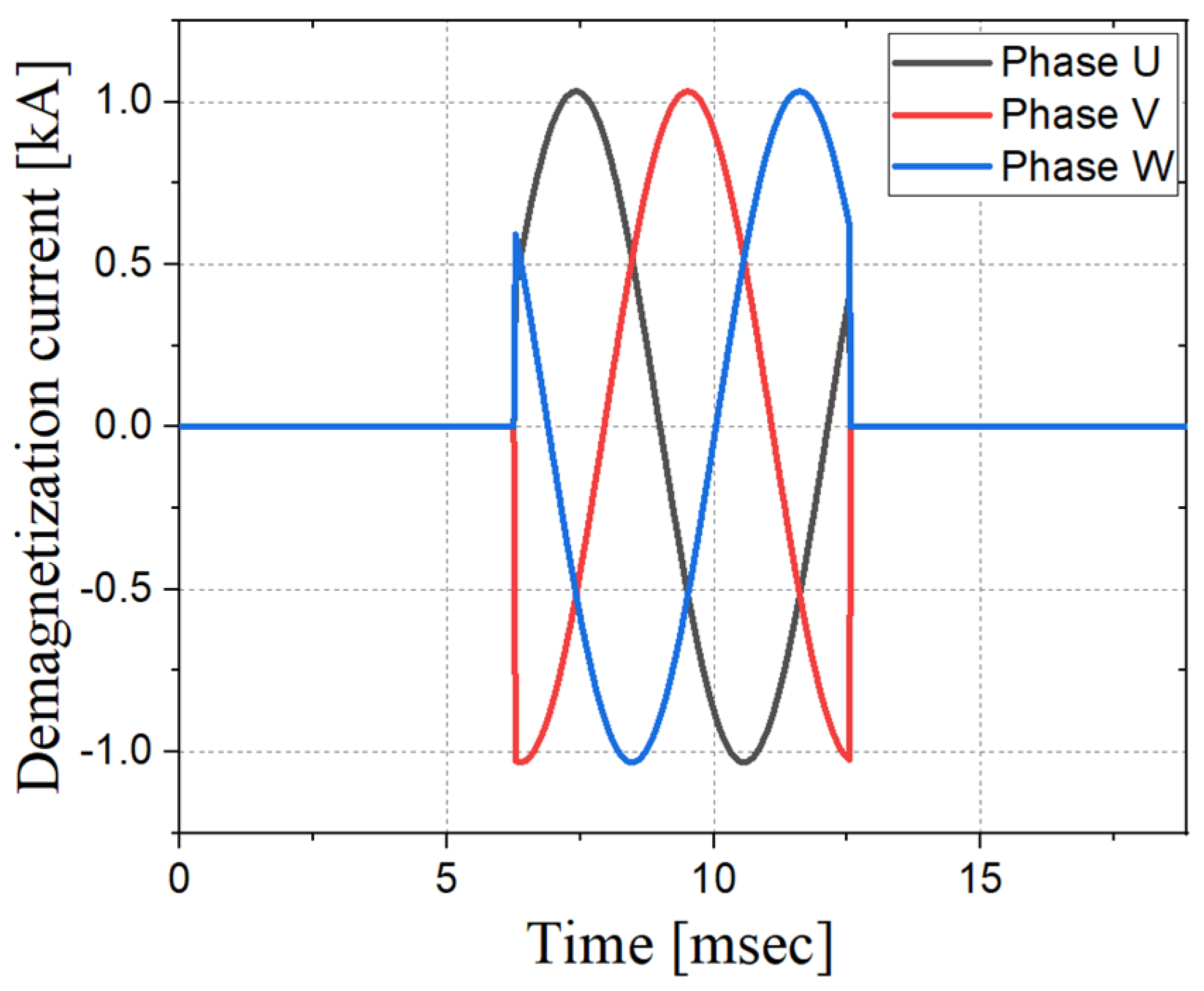
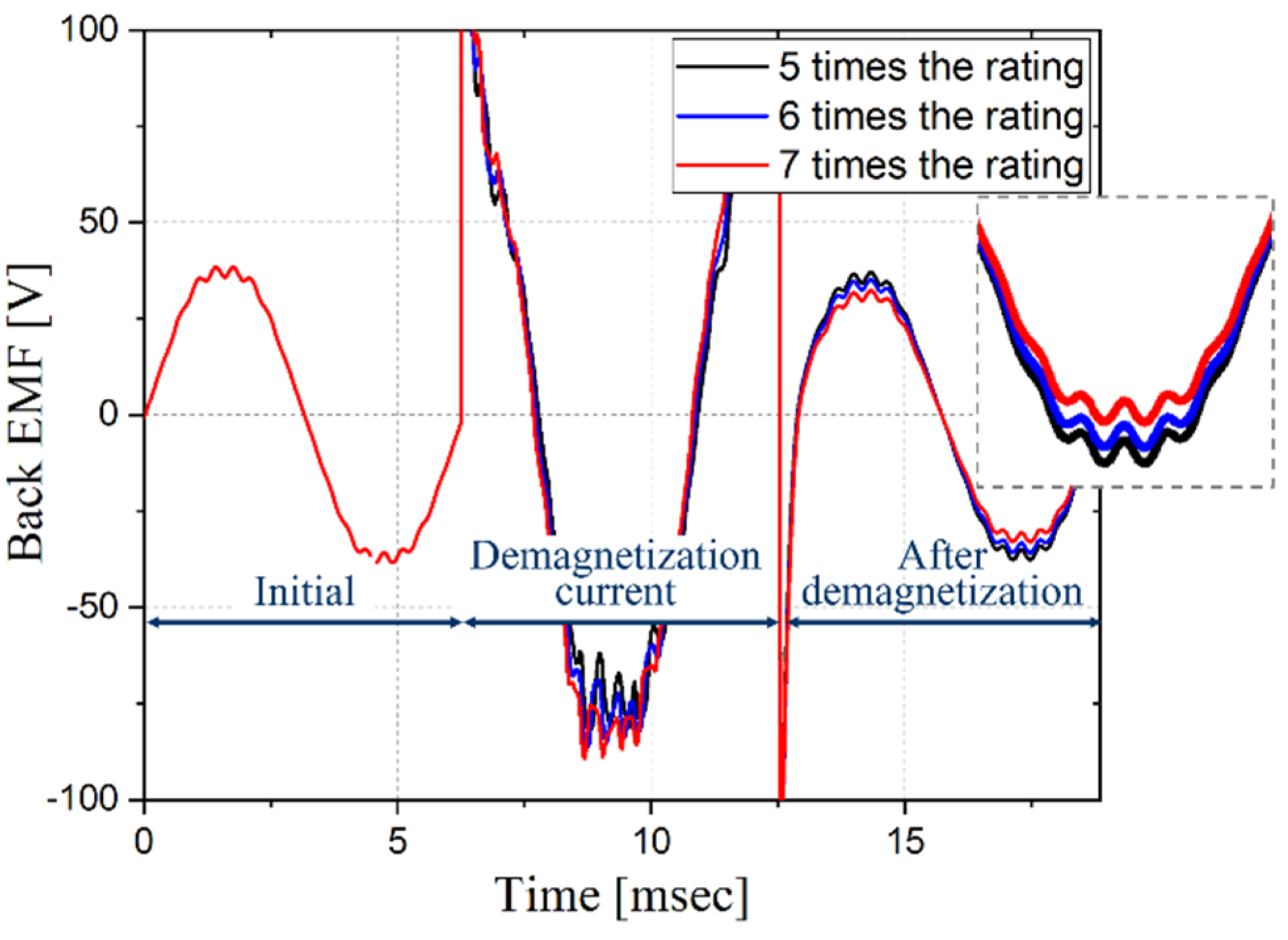
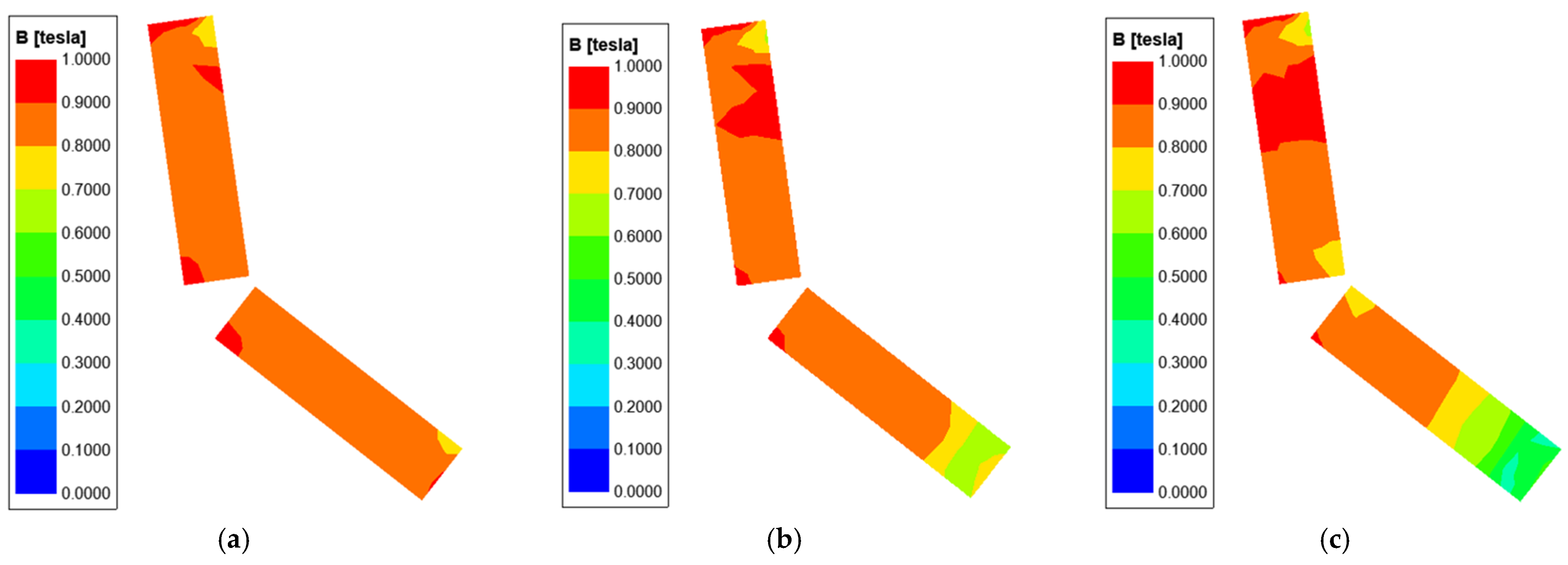

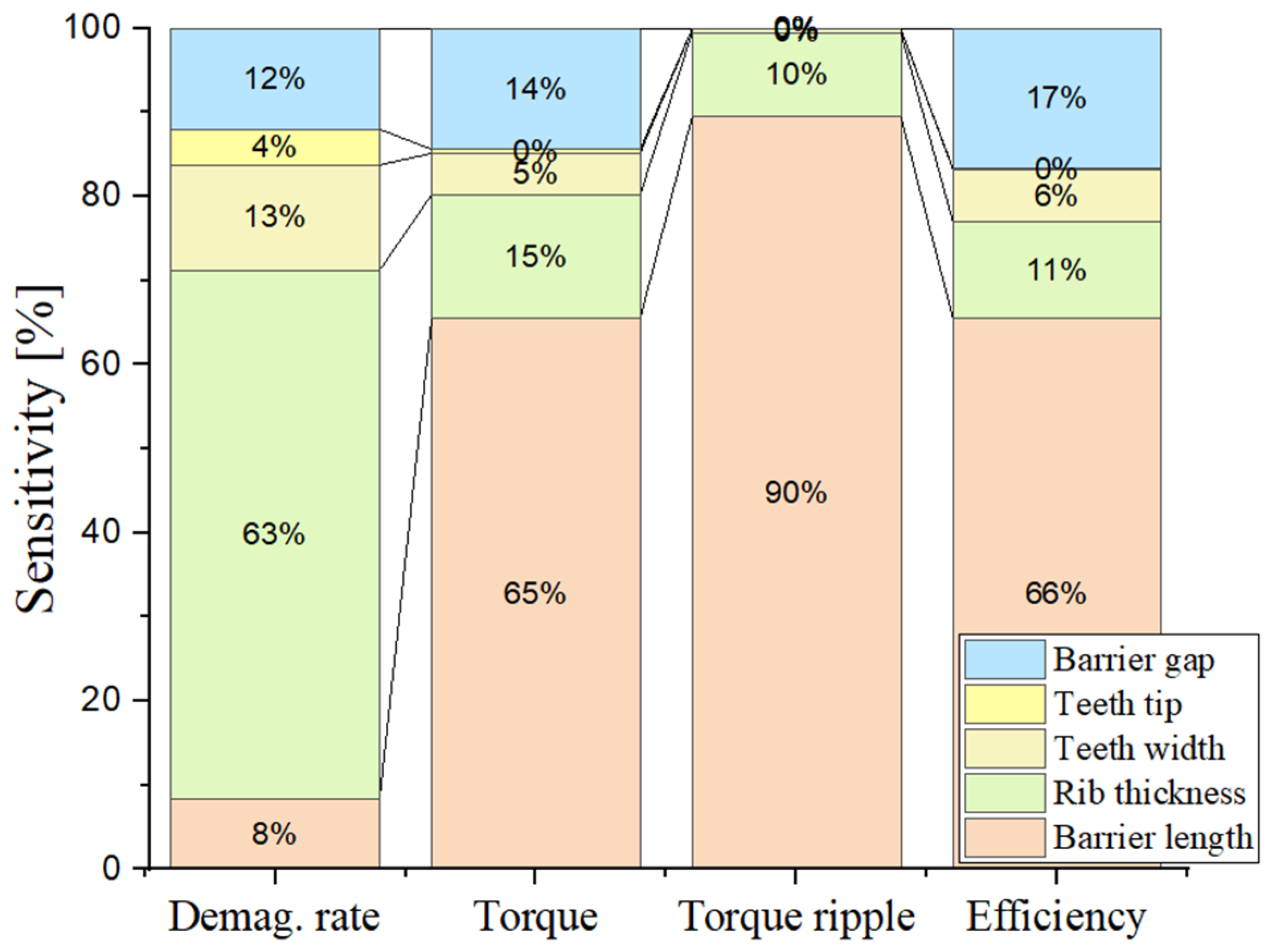

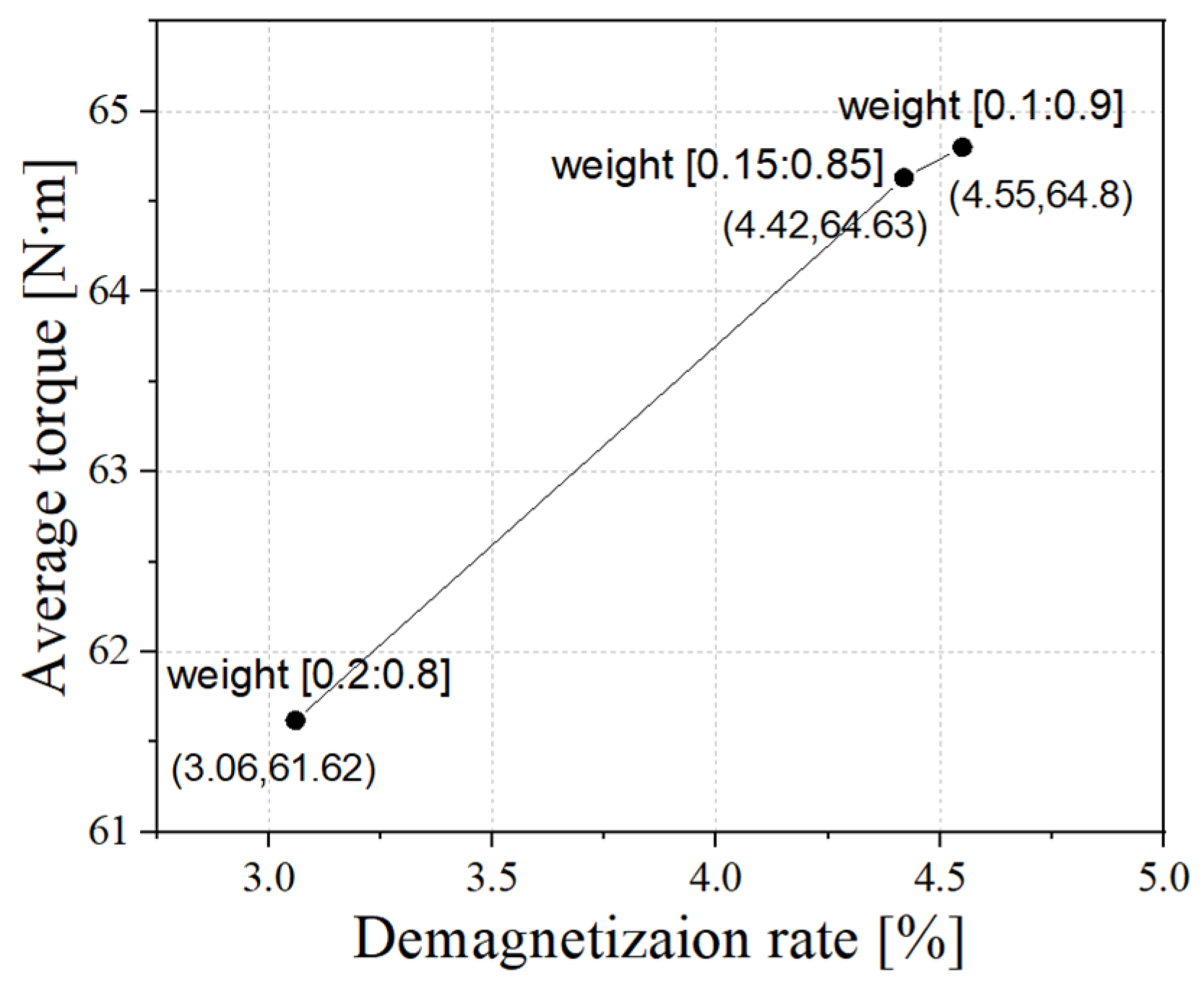
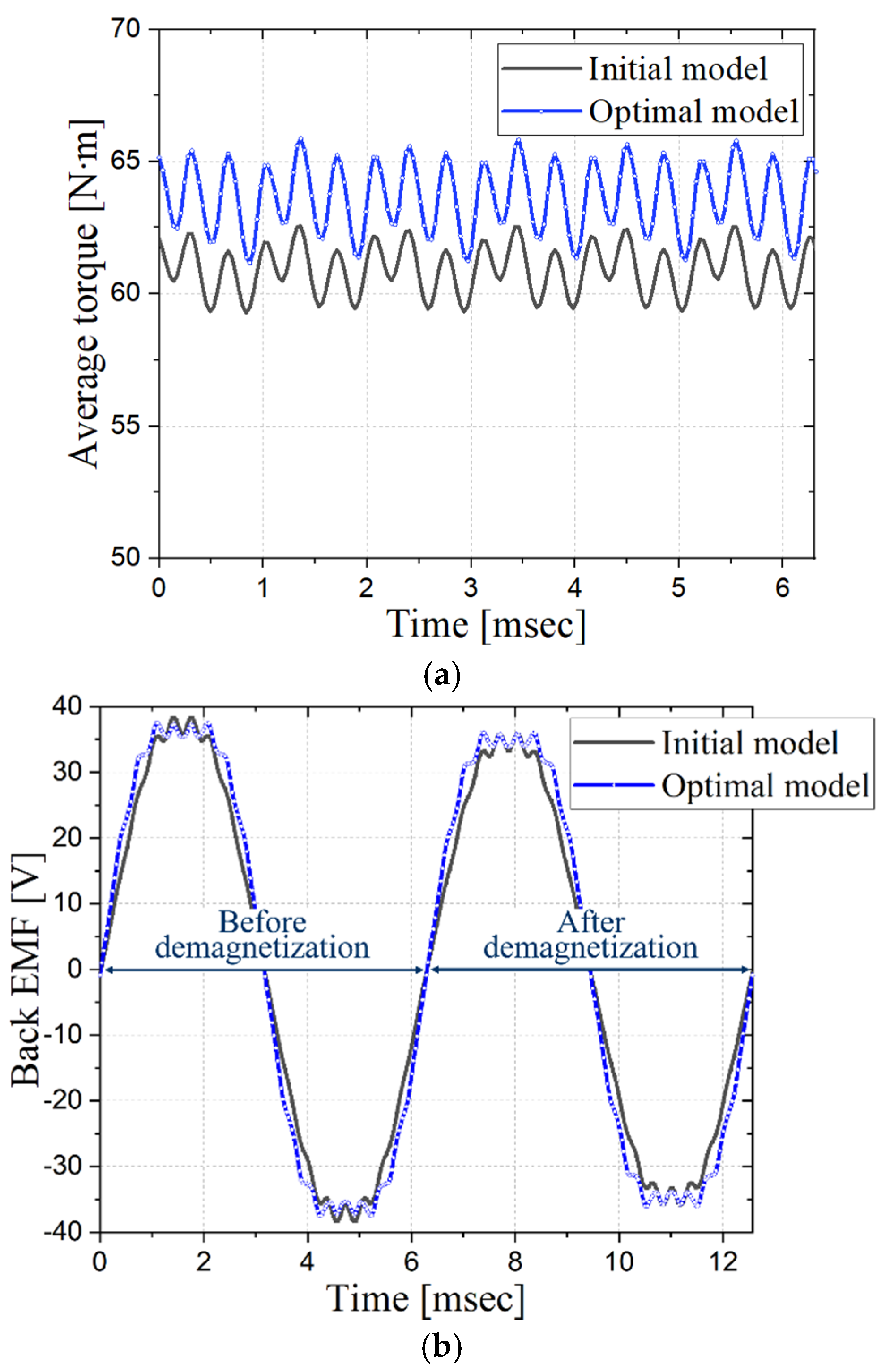
| Items | Unit | Value | |
|---|---|---|---|
| Target | Maximum output power | kW | 15 |
| Maximum torque | N∙m | 60 | |
| Rated speed | rpm | 2387 | |
| Material | Permanent magnet | - | 35PN210 (POSCO) |
| Electrical steel | - | N39UH (ShinEtsu) | |
| Electrical | Continuous current | Arms | 146 |
| Current phase angle | ° | 25 | |
| Phase resistance | Ω | 0.021 | |
| Mechanical | Stator outer diameter | mm | 202 |
| Rotor outer diameter | mm | 138 | |
| Air-gap length | mm | 1 | |
| Lamination length | mm | 45 | |
| Thermal | Reference temperature | °C | 20 |
| Demagnetization temperature | °C | 150 | |
| Design Variables | Unit | Lower Limit | Upper Limit | Considerations |
|---|---|---|---|---|
| Barrier length | mm | −4 | 10 | Magnetic flux flow |
| Rib thickness | mm | −1 | 0.5 | Mechanical stiffness and interference |
| Teeth width | mm | −1 | 0 | Coil fill factor and magnetic saturation |
| Teeth thickness | mm | 0 | 1 | |
| Barrier gap | mm | 0 | 2 | Mechanical interference and magnet flux flow |
| Design Variables | Unit | Initial Model | Best Point |
|---|---|---|---|
| Barrier length | mm | 0 | −3.72 |
| Rib thickness | mm | 0 | 0.07 |
| Teeth width | mm | 0 | 0.44 |
| Teeth thickness | mm | 0 | 0.62 |
| Barrier gap | mm | 0 | 1.36 |
| Demagnetization rate | % | 6.397 | 2.466 |
| Average torque | N∙m | 60.936 | 59.846 |
| Torque ripple | % | 5.202 | 4.939 |
| Efficiency | % | 91.550 | 91.398 |
| Metamodel | Demanetizaion Rate | Torque | Torque Ripple | Efficiency |
|---|---|---|---|---|
| Krigging | 0.299578388 | 0.480370464 | 0.661102263 | 0.068150470 |
| RBF (Interpolation) | 0.162832835 | 0.316088471 | 1.684960769 | 0.054181548 |
| RBF (Regression) | 0.184083130 | 0.185910892 | 1.660534066 | 0.049919916 |
| PRG (Forward step) | 0.219662647 | 0.199215669 | 1.649310197 | 0.054889271 |
| PRG (Backward step) | 0.245157992 | 0.365451547 | 1.344382800 | 0.041693768 |
| PRG (Linear) | 0.281644165 | 0.811042784 | 1.465072536 | 0.105565885 |
| PRG (Simple quadratic) | 0.249900294 | 0.907408134 | 1.366168145 | 0.126547557 |
| PRG (Full quadratic) | 0.194996813 | 0.197566341 | 1.847404658 | 0.037366471 |
| PRG (Simple cubic) | 0.195295038 | 0.221251507 | 1.524009121 | 0.034044144 |
| EDT (Hybrid) | 0.563395063 | 0.855283102 | 1.071512674 | 0.116880624 |
| EDT (Hybrid / opt.) | 0.486268030 | 0.767061634 | 1.265285952 | 0.094801174 |
| MLP | 0.252059717 | 1.833024299 | 1.687341801 | 0.168041319 |
| MLP (Custom) | 0.111563863 | 0.159207851 | 1.861550458 | 0.114412812 |
| Items | Unit | Initial (FEA) | Optimal (Metamodel) | Optimal (FEA) |
|---|---|---|---|---|
| Barrier length | mm | 0 | −3.999 | |
| Rib thickness | mm | 0 | 1.000 | |
| Teeth width | mm | 0 | 0.000 | |
| Teeth thickness | mm | 0 | 0.771 | |
| Barrier gap | mm | 0 | 2.000 | |
| Demagnetization rate | % | 6.397 | 4.554 | 3.729 |
| Average torque | N∙m | 60.936 | 64.795 | 63.648 |
| Torque ripple | % | 5.202 | 6.299 | 7.010 |
| Efficiency | % | 91.550 | 91.882 | 91.841 |
Publisher’s Note: MDPI stays neutral with regard to jurisdictional claims in published maps and institutional affiliations. |
© 2021 by the authors. Licensee MDPI, Basel, Switzerland. This article is an open access article distributed under the terms and conditions of the Creative Commons Attribution (CC BY) license (http://creativecommons.org/licenses/by/4.0/).
Share and Cite
You, Y.-m.; Yoon, K.-y. Multi-Objective Optimization of Permanent Magnet Synchronous Motor for Electric Vehicle Considering Demagnetization. Appl. Sci. 2021, 11, 2159. https://doi.org/10.3390/app11052159
You Y-m, Yoon K-y. Multi-Objective Optimization of Permanent Magnet Synchronous Motor for Electric Vehicle Considering Demagnetization. Applied Sciences. 2021; 11(5):2159. https://doi.org/10.3390/app11052159
Chicago/Turabian StyleYou, Yong-min, and Keun-young Yoon. 2021. "Multi-Objective Optimization of Permanent Magnet Synchronous Motor for Electric Vehicle Considering Demagnetization" Applied Sciences 11, no. 5: 2159. https://doi.org/10.3390/app11052159
APA StyleYou, Y.-m., & Yoon, K.-y. (2021). Multi-Objective Optimization of Permanent Magnet Synchronous Motor for Electric Vehicle Considering Demagnetization. Applied Sciences, 11(5), 2159. https://doi.org/10.3390/app11052159





